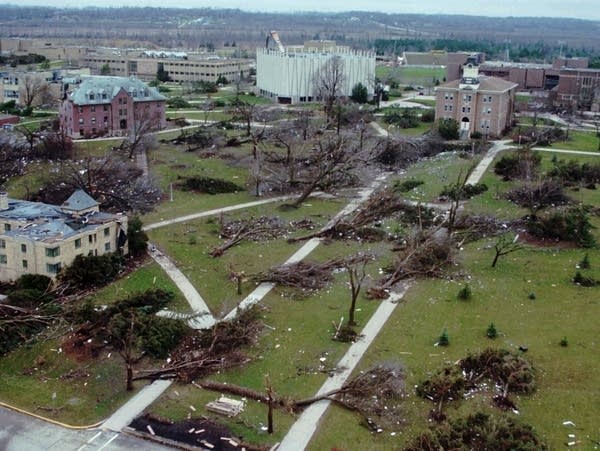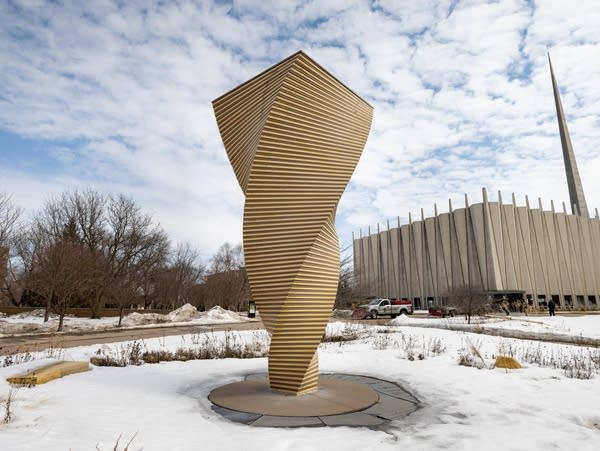25 years after tornadoes tumbled southern Minnesota, residents still carry the lessons learned

Go Deeper.
Create an account or log in to save stories.
Like this?
Thanks for liking this story! We have added it to a list of your favorite stories.
On March 29, 1998, Lynette Nyman, just three months into her job as a St. Peter-based MPR News reporter received a quick visit from a fellow journalist.
“Just as she was leaving, she’s like, ‘Oh, well take care. You know, have fun!’ Nyman remembers. And then Nyman responded in a way she will never forget.
“‘Oh, no nothing ever happens here.’ I literally said those words,” she said. “Nothing ever happens here. And then, just after five o’clock, everything changed.”

Fourteen tornadoes swept through the region. The worst damage was in Comfrey and the Lake Hanska area. In St. Peter, an F-3 tornado destroyed more than 200 homes. It tore up trees and flattened schools and businesses.
Turn Up Your Support
MPR News helps you turn down the noise and build shared understanding. Turn up your support for this public resource and keep trusted journalism accessible to all.
Two people died in the outbreak: an 85-year-old man near Lake Hanska and a six-year-old boy near St. Peter.

Nyman, who was on the ground reporting for months in the aftermath, interviewed her neighbors and friends within St. Peter while also processing what happened to her town. The radio studio where Nyman was based on the Gustavus Adolphus campus was destroyed, forcing her to create a makeshift newsroom out of her home.
As Nyman navigated the story, she also lived with the same unknowns as her neighbors and friends who were rebuilding their lives after losing almost everything. It was hard to process, she says she had a duty to bring the stories of those affected to the listeners who learned about what happened over the air.
She shared stories such as a woman reuniting with her love letters written by her deceased husband, a man rebuilding his home and community members picking out shards of glass from the grass so that the children could run and play, piecing together some semblance of normalcy.

Nyman said it shaped her later work at the American Red Cross, sharing the stories of people affected by crisis and disaster. Also learning that recovery after disaster doesn’t happen overnight.
“The challenge is to not harden the heart so that we’re keeping our own vulnerability there as well,” Nyman said. “Just so that we’re really connecting with people. And it’s not just, ‘Oh, this is just another story.’”
What happened that day, the months after and even decades later, Nyman said those lessons still stayed with her.
“At the end of the day, for me, I want to say, ‘where is their dignity?’” she said. “That’s the ultimate question. You know, is there dignity for the person I’m interviewing? Is there dignity for me, and for those affected?”

Piecing campus and home back together
Recently Gustavus Adolphus students walked the campus between classes and ate lunch in the dining hall. Many of them possibly were unaware of what happened to their school a quarter century ago.
Associate Vice President of Auxiliary Services Steve Kjellgren is one of the few administrators left at Gustavus who 25 years ago helped lead the campus tornado response.
The storm blew out 80 percent of the windows on campus and uprooted more than 2,000 mature trees. The chapel steeple snapped. The clock on the clock tower stopped running, frozen at the moment when the tornado severely damaged the school.
Kjellgren said it turned everyone’s life upside down.

“I think we all were just so focused on what we needed to do,” Kjellgren said. “And also, for those of us who lived in town, we were working here to try to put Gustavus back together, but we’re also trying to put our own homes together, and what our children are going to do for school.”
Most students were away from campus for spring break. Though it seemed like a monumental task, somehow, Gustavus reopened for students within three weeks to finish the school year, and made sure the class of 1998 graduated on time.
For the next two decades campus emergency plans were shaped by those who took part in the tornado response. Kjellgren says they created plans to guide staff response in times of crisis and uncertainty. That readiness was apparent at Gustavus during the COVID-19 pandemic.
“Don’t think it’s too much work to plan ahead,” he said. “Because you never know when you got to pull that thing off the shelf, blow the dust off and get to work.”

From the fingerprints
Twenty-five years later, St. Peter displays the resilience of people overcoming tragedy together. From younger trees that were planted, to the rebuilt library and the framed flag that once flew over the old community center that now hangs in the new building.
In the decade after the storms, the population didn’t drop. Rather, it grew as fast as North Mankato or Mankato, some believing it was the stories and testament of small town spirit to rebuild drew others from all over.

City Administrator Todd Prafke said traces of the tornado and what happened on March 29, can still be found around town. And, he said, they will be for a long time.
“I don’t think it’s necessarily a bad thing,” Prafke said. “I think it provided us with opportunity. It provided us with ways and mechanisms to make decisions, maybe better or differently than we might have otherwise.”
Prafke said community members learned to help others who may be in a similar process and not to give up hope.
The lessons from disaster are carried with them forever.
“That’s what people in St. Peter will do,” he said. “That’s, I mean, that’s just how it will be. That’s how it will be.”


